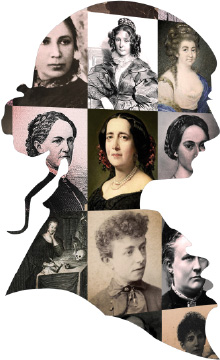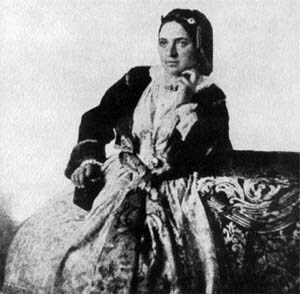Milica Stojadinović
1828–1878| Pseudonyms | Srpkinja |
|---|---|
| Date of birth | 1828 |
| Date of death | July 25, 1878 |
| Web address |
Personal situation
Milica Stojadinović Srpkinja, "The Fairy from Vrdnik", was born in Bukovac, Srem (then in the Austrian Empire), somewhere around 1828, or 1830. In her youth, she became famous for her patriotic poetry, which was concerned with the national awakening. Her first poem, "Mladi Srbin" ("The Young Serb") was published in Srbski narodni list (Serbian National Journal) in 1845 in Pest. In 1848, she came into conflict with the Hungarian authorities due to censorship. Her first book of poems, Pesme (Poems), was published in 1850, and, later on, two expanded editions were issued in 1855, and 1869. She also published a journal entitled U Fruškoj gori 1854 (In Fruška Gora in 1854), in three volumes, issued in 1861, 1862, and 1866. She spoke and translated from German. Milica is also considered to be the first woman war correspondent, as she wrote a report about the bombing of Belgrade in 1862. She died in Belgrade (Serbia), in 1878, forgotten and in poverty.
| Place of birth | Bukovac, Srem |
|---|---|
| Place(s) of residence | Serbia |
| Place of death | Beograd |
| Nationality | Serbian |
| First language(s) | Serbian |
| Marital status | Single |
| Education | School education |
Professional situation
Poetess, writer and folklore collector, translator.
She spoke German, and probably Slovakian, and she also learned Italian and French.
She published her first poem in a magazine in Pest, in 1847. Her poems were later published in various magazines: Sedmica (Seven), Vojvođanka (Vojvodina Woman), Šumadinka (Šumadija Woman), Fruškogorka (Fruška Gora Woman), Danica, and, without signature, in Putnik (Traveler) and Komarac (Mosquito).
She traveled twice to Vienna (1851, 1954), and had meetings with Vuk Karadžić and his daughter Mina there. She had professional contact with some of the greatest Serbian poets of the time, like Petar II Petrović Njegoš, Ljubomir Nenadović, Đorđe Rajković. She also collaborated with Vuk Stefanović Karadžić, the central figure of Serbian culture in the 19th century. She gathered the folklore of Vojvodina for his books. In her journal, she mentiones oral singers, from whom she collected folk poetry: blind Jela, Pava, Kata, Ruža, Ana, and Anđelija. She published many of these folklore elements in her journal. She was a translator, too; she translated Goethe and Balzac.
She was also a friend of the Austrian poet Ludwig August von Frankl.
Her most important works include:
Pesme (Poems), 1850. (first edition)
U Fruškoj gori 1854. (In Fruška Gora in 1854), 1861. (first edition)
Her diary had 433 subscribers in: Viena (200), Budim (20), Belgrade (84), Šabac (20), Vukovar (40), Karlovci (49), and Mitrovica (20).
| Profession(s) and other activities | poet |
|---|---|
| Language(s) in which she wrote | Serbian |
Works by this author
Monographs
- Ljubomir Nenadović. Milica Stojadinović Srpkinja 2017
- Pesme 1850
- Pesme, knjiga 2 1855
- U Fruškoj gori 1854. 1861
- U Fruškoj gori 1854. sv. 2 1862
- U Fruškoj gori 1854. sv. 3 1866
- Pesme Milice Stojadinović 1869
- U Fruškoj gori 1854. 1985
- Iz kolebe u dvorove gospodske : folklorna zbirka Milice Stojadinović Srpkinje 1990
- Prepiska Milice Stojadinović Srpkinje sa savremenicima 1991
- Pesme 2008
- Pesme 2008
- U Fruškoj gori 1854. Spomenica M. S. S. 2008
- Najlepše ljubavne pesme srpskih pesnikinja 2013
Articles and other similar texts
- Nacionalne boje 1300–2000
- Mladi Srbin 1847
- Večernja molitva Srbina u oči Novog Leta 1848 1848
- Slovenska lipa 1849
- Srbkinja na ušću Drine 1851
- Pitanje 1851
- Venac za vrline 1851
- Čiči, vitezu Jarka 1851
- Prolazećim graničarima u Italiju 1850 god. 1851
- Pozdrav rodu na Novo leto 1851 1851
- Vijenac srpskom pjesniku Vladici Crnogorskom Petru Petroviću Njegošu 1852
- Na Vidovdan 1853
- Jesenja pesma 1853
- Ljubav i vernost 1855
- Večni spomen materi mojoj Jelisaveti Stojadinović, umrloj na Cveti, četvrtak 1855 1855
- Srbiji 1855
- Prosveti 1860
- U zimu 1864
- Hristos se rodi 1864
- Pisma Đorđu Rajkoviću od Milice Stojadinović 1889
- Na grobu svoga brata 1892
- Pisma Milice Stojadinović Srpkinje upućena Ludviku Avgustu Franklu 1905
- Pesme udaljenog 1907
- Pisma bosanska 1907
- Pesma jednog večera 1907
- Srpsko vojvodstvo 1907
- Pismo Milice Stojadinović upućeno pretsedniku Ministarstva Stevči Mihajloviću 1956-7
Non-book materials/ Other material
- Srca i barikade 1862
Translations
- Titir i Menelka 1852
- Mirtil i Dafne 1852
- Dvoguba zakletva popravljena 1852
- Iskre iz Geteovog genija 1852
Reception
Reception during lifetime
Reception after death
- Iz srpske književnosti. Slike i rasprave (1898)
- Zanimljive priče i beleške iz života znamenitih Srba (1900)
- Jedna austro-srpska pesnikinja, Milica Stojadinović (1906)
- Spomenica Milice Stojadinović Srpkinje (1907)
- *o Milici (1907)
- Pisci i knjige 1 (1907)
- Milica Stojadinović - Srpkinja, književna slika (1907)
- Milica Stojadinović-Srpkinja (1912.)
- Otkrivanje spomenika Milici Stojadinović "Srpkinji" (1912.)
- Spomenik Milici Stojadinovićevoj Srpkinji (1912)
- O Milici Stojadinovićevoj Srpkinji (1912)
- Spomenik Milice Stojadinovićeve-Srpkinje (1912.)
- Pred spomenikom Milice Stojadinovićeve-Srpkinje (1912.)
- Pred spomenikom Milice Stojadinovićeve-Srpkinje (1913)
- O Milici Stojadinović Srpkinji (1913)
- Prvi i poslednji dan sa Milicom-Srpkinjom (1913)
- Svetoj sjeni Milice Srpkinje (1913)
- Iz života i rada Milice Stojadinović-Srbkinje (1926)
- Dosljednost jedne ljubavi (1926)
- Milica Stojadinović Srpkinja i Draga Dejanović o ženama (1930)
- Bibliografija knjiga ženskih pisaca štampanih u Vojvodini,Srbiji, Južnoj Srbiji i Crnoj Gori do svršetka 1935. (1936)
- Naša žena u književnom stvaranju (1941)
- Milica Stojadinović - Srpkinja (1964)
- Helenski vidici (1966)
- Milica Stojadinović - Srbkinja (1967)
- Branko Radičević prilog istoriji nove srpske književnosti (1980)
- Istorija srpske književnosti (1983)
- Milica Stojadinović - Srpkinja (1985)
- Sumnje i nadanja (1986)
- Milica Stojadinović Srpkinja u prepisci sa Vukom Karadžićem (1987)
- Predgovor (1991)
- "Ovde srpska pevačica nema potpomaganja.." (Iz prepiske Vuka i Milice Stojadinović Srpkinje) (1991)
- Hiti Dunav da prebrodi : Pančevo u pevanoj rodoljubivoj pesmi Milice Stojadinović Srpkinje (1992)
- Milica Stojadinović Srpkinja i Srem : porodično stablo (1993)
- Proizvoljnost dnevnika (1994)
- Poslednji zanosi MMS (1996)
- Moje ime je nemogućnost: razmišljanja o drugoj književnoj istoriji (2000)
- O ženama i književnosti na početku veka (2000)
- Voices in the Shadows: women and verbal art in Serbia and Bosnia (2000)
- Milici na utehu - al niotkud nade nije (170 godina od rođenja - 120 godina od smrti) (2001)
- Milica i Šid (2001)
- Milica Stojadinović – Srpkinja (2002)
- Milica Stojadinović Srpkinja (2002)
- Transcribing the voice of the mother: The diary of Milica Stojadinovic Srpkinja (2006)
- My Name is Impossibility:” Observations on An/Other Literary History (2006)
- When we mature as a culture. Early 20th-century Serbian Women's Writings (canon-genre-gender) (2007)
- Bibliografija radova o Milici Stojadinović Srpkinji (2007)
- Život i književno delo Milice Stojadinović Srpkinje (2010)
- Obnova romantike : Milica Stojadinović Srpkinja : [savremenici o Milici Stojadinović Srpkinji] (2010)
- Žena u srpskoj književnosti (2010)
- ...kada sazremo kao kultura... Stvaralaštvo srpskih spisateljica na početku XX veka (kanon – žanr – rod) (2012)
- Selektivna bibliografija tekstova o Milici Stojadinović Srpkinji (2013)
- Srpkinja brani ,,Spisateljku": apologetski diskursi u dnevniku Milice Stojadinović Srpkinje (2014)
- Materinski glas u dnevniku Milice Stojadinović Srpkinje (2015)
- Milica Stojadinovićeva Srpkinja – zaboravljena pisma, rukopisi, slike, note (2015)
- Jedno neobjavljeno pismo Milice Stojadinović Srpkinje (2018)
- Pozdrav Milici Stojadinović Srpkinji (2019)
- Francuska veza (2019)
Authors read by this author
* Only authors in Knjiženstvo DB are shown



